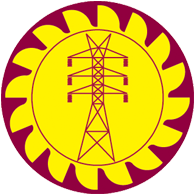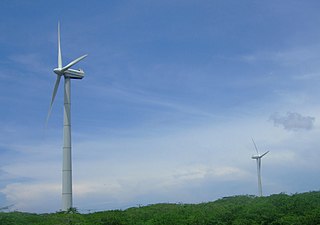
Solar power in Australia is a fast growing industry. As of April 2022, Australia's over 3.12 million solar PV installations had a combined capacity of 26,093 MW photovoltaic (PV) solar power, of which at least 4,342 MW were installed in the preceding 12 months. In 2019, 59 solar PV projects with a combined capacity of 2,881 MW were either under construction, constructed or due to start construction having reached financial closure. Solar accounted for 9.9% of Australia's total electrical energy production in 2020.

The Ceylon Electricity Board - CEB, is the largest electricity company in Sri Lanka. With a market share of nearly 100%, it controls all major functions of electricity generation, transmission, distribution and retailing in Sri Lanka. It is one of the only two on-grid electricity companies in the country; the other being Lanka Electricity Company (LECO). The company earned approximately Rs 204.7 billion in 2014, with a total of nearly 5.42 million consumer accounts. It is a government owned and controlled utility of Sri Lanka that takes care of the general energy facilities of the island. The Ministry of Power and Energy is the responsible ministry above the CEB. Ceylon Electricity Board (CEB), established by an CEB Act No. 17 of 1969, is under legal obligation to develop and maintain an efficient, coordinated and economical system of Electricity supply in accordance with any Licenses issue.

The Lakvijaya Power Station is the largest power station in Sri Lanka.

The Hambantota Wind Farm was a wind farm in Hambantota, Sri Lanka, owned and operated by the state-run Ceylon Electricity Board. The wind farm, which was located along south-eastern coast of Hambantota was the country's first state owned wind farm, and consisted of five NEG Micon M1500-600 wind turbines of 600 KW each. With a total installed capacity of 3 MW, the wind farm generated up to approximately 4,500 MWh of power a year.

The electricity sector in Sri Lanka has a national grid which is primarily powered by hydroelectric power and thermal power, with sources such as photovoltaics and wind power in early stages of deployment. Although potential sites are being identified, other power sources such as geothermal, nuclear, solar thermal and wave power are not used in the power generation process for the national grid.
The Sampur Power Station was a proposed coal-fired power station that was planned to be built in Sampur, Trincomalee, Sri Lanka.

Hayleys PLC was founded in 1878 and has since become one of Sri Lanka's largest multinational and diversified conglomerate. Hayleys single-handedly accounts for approximately 4.2% of Sri Lanka's export income, and 3.9% of the country's tea and 4.5% of its rubber production. With over 30,000 employees, Hayley was also the first listed entity in the country to surpass annual revenue of US$1 billion in Fiscal Year 2017/18. The company operates over 16 business sectors: eco-solutions, hand protection, purification, agriculture, consumer and retail, leisure, textile manufacturing, construction materials, plantations, industrial solutions, power and energy, transportation and logistics, BPO, tea exports, projects and engineering, and investments and services. Hayleys comprises over 130 business units and subsidiaries, nine of which are publicly listed in the Colombo Stock Exchange. In addition to Sri Lanka, Hayleys today has manufacturing facilities in Indonesia and Thailand and marketing operations in Australia, India, Bangladesh, Italy, Japan, Netherlands, UK and USA and its products are sold in 80 countries.

NTPC Limited, formerly known as National Thermal Power Corporation Limited, is an Indian public sector undertaking which is engaged in generation of electricity and allied activities. The headquarters of the company is situated at New Delhi. NTPC's core function is the generation and distribution of electricity to State Electricity Boards in India. The body also undertakes consultancy and turnkey project contracts that involve engineering, project management, construction management, and operation and management of power plants.
The Hambantota Solar Power Station is the first commercial-scale solar power station in Sri Lanka. The photovoltaic solar facility was constructed in Buruthakanda, in the Hambantota District. The plant is owned and operated by the Sri Lanka Sustainable Energy Authority, a state-run organization responsible for renewable resources.
The Nirmalapura Wind Farm is a 10 MW wind farm consisting of seven wind turbines, located on the west coast of Nirmalapura, Puttalam, Sri Lanka. The plant is owned by Nirmalapura Wind Power (Private) Limited, and was commissioned in September 2011.
Chunnakam Power Station was a thermal power station in Chunnakam in northern Sri Lanka. Commissioned in 1958, the station is owned and operated by the state-owned Ceylon Electricity Board (CEB). It was decommissioned in 2013, and replaced by the Uthuru Janani Power Station, which is constructed less than 100m south of the Chunnakam Power Station.
The Boulder Solar project is a 150 megawatt (MWAC) photovoltaic power station near Boulder City, Nevada. It was built in two phases by SunPower using its Oasis Power Plant system. The project is co-located with several other large solar power projects in the Eldorado Valley.

The Thambapavani Wind Farm named after Thambapanni and Pavan meaning wing in Sinhalese. Also called Mannar Island Wind Farm or Mannar Wind Farm) is a 100-megawatt wind farm which was built on the southern coast of the Mannar Island, in Sri Lanka. The project would cost approximately US$200 million, 78% of which will be borne by the Asian Development Bank, while the remaining 22% will be borne by the developers, the Ceylon Electricity Board. Identification of land plots and ownership has already begun. It is currently regarded as the largest wind farm in Sri Lanka and it is also the first wind power plant to be owned by the Ceylon Electricity Board.
The Maduru Oya Solar Power Station is a proposed 100 megawatt floating solar photovoltaic power station to be built over 500 acres (2.0 km2) - or 2%, of the Maduru Oya Reservoir. Following the cabinet approval in 2017, the Ministry of Science and Technology has allocated Rs. 80 million(about US$ 522,000) for obtaining of required equipment and materials for a prototype training project.
The Aitken Spence Power Station is a municipal solid waste-fired thermal power station currently under construction at Muthurajawela, Sri Lanka. It was originally planned to be built at Meethotamulla, the site of a large solid waste landfill which was under international media spotlight after the 2017 Meethotamulla garbage landslide which killed over 30 people. The power station will operate approximately 7500 hours a year, utilizing the 700 metric tons (1,500,000 lb) of fresh waste from the Colombo Municipal Council area, daily. The power station in being built together with the KCHT Power Station.
The KCHT Power Station is a municipal solid waste-fired thermal power station currently under construction at Muthurajawela in Sri Lanka. It is being constructed together with the Aitken Spence Power Station, after it won the bid by the Urban Development Authority from a pool of 121 bidders, 19 of which were foreign. Construction of the facility began on 10 August 2017 and will cost approximately US$95 million, with an estimated completion slated for mid-2019.
The Colombo South Waste Processing Facility is a municipal solid waste-fired thermal power station currently under construction at a 10-acre (40,000 m2) site in Karadiyana, Sri Lanka. Together with the KCHT Power Station, it is one of two projects that won the bid by the Urban Development Authority, from a pool of 121 bidders. Construction of the facility began on 23 August 2017 with a completion slated for mid-2019. The estimated cost of the project is approximately US$91 million.
The Sagasolar Power Station is a solar photovoltaic power station built next to the Hambantota Solar Power Station, in Hambantota, Sri Lanka. The solar farm is owned and developed by Sagasolar, a joint venture between LOLC Group and Faber Capital Limited, with 70% debt funded by DFCC Bank, Commercial Bank of Ceylon, and Hatton National Bank. The 10-megawatt facility is expected to generate approximately 19GWh annually for at least 25 years.

WindForce PLC is the largest renewable energy private sector company in Sri Lanka. The company was incorporated in 2010 and in 2021 was listed on the Colombo Stock Exchange. The company commission, construct and operate power plants and generate power through wind, solar and hydropower.









